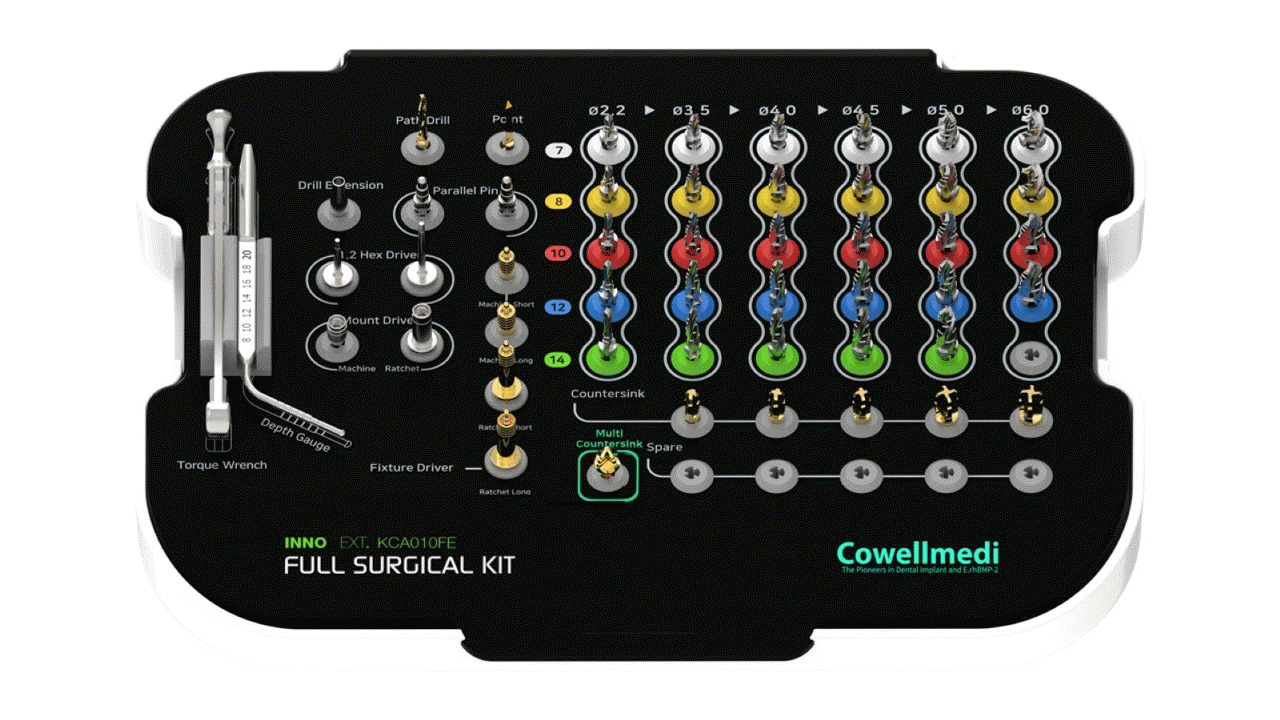Advertisement

For INNO Ext. (External type)
*Composition*
Point Drill
> Primarily used to mark the implant recipient site and determine the spacing.
> The point drill has a unique pointed tip, making this an excellent drill for starting the osteotomy
through the hard cortical plate.
Path Drill
> Used for the case that path modi cation is required.
> Excellent ablation force that does not slip in slanted bone.
> Easy to drill even in extraction socket without slipping.
Initial Drill
> Initial stepped drill - Ø2.2, Ø2.8, and Ø3.3mm stepped drilling at the Ø1.8 drilled site.
Final Drill
> Ø 3.5 / 4.0 / 4.5 / 5.0 / 6.0
> 7 / 8 / 10 / 12 / 14 / 16 / 18mm
Countersink
> Used to prevent compressive necrosis of dense cortical bone by decreasing torque force
(Ø4.0 Fixture: 80N.cm -> 45N.cm / Ø5.0 Fixture: 150N.cm -> 45N.cm).
> Bone quality 1: high compressive placement of xtures induces the failure of osseointegration and bone loss.
Drill Extension
> Used for lengthening the Drill when using a Hand-piece.
> Do not go over recommended torque when using the Drill Extension.
> The triangle mark indicates the cutting surface of the drill shaft.
Hex Driver
> Used to install or remove the Cover Screw, Healing Abutment, and Abutment Screw, etc.
> The Machine Drivers are used with contra angle, while the Ratchet Drivers are used with the Torque Wrench.
Fixture Driver
> Used to install No-Mount type fixtures.
> The Machine Drivers are used with a contra-angle, while the Ratchet Drivers are used with the Torque Wrench.
Torque Wrench
> Used to control torque force in the xture and abutment placement.
> Torque force 10, 25, 30 & 35N.cm are able to be controlled by pulling the elastic bar.
> Maximal torque force 120N.cm with pulling the rigid main bar.
Depth Gauge
> Used to measure the drilling depth with the scale rod.
> The at end on the other side measures the 5mm space between adjacent fixtures.
*Composition*
Point Drill
> Primarily used to mark the implant recipient site and determine the spacing.
> The point drill has a unique pointed tip, making this an excellent drill for starting the osteotomy
through the hard cortical plate.
Path Drill
> Used for the case that path modi cation is required.
> Excellent ablation force that does not slip in slanted bone.
> Easy to drill even in extraction socket without slipping.
Initial Drill
> Initial stepped drill - Ø2.2, Ø2.8, and Ø3.3mm stepped drilling at the Ø1.8 drilled site.
Final Drill
> Ø 3.5 / 4.0 / 4.5 / 5.0 / 6.0
> 7 / 8 / 10 / 12 / 14 / 16 / 18mm
Countersink
> Used to prevent compressive necrosis of dense cortical bone by decreasing torque force
(Ø4.0 Fixture: 80N.cm -> 45N.cm / Ø5.0 Fixture: 150N.cm -> 45N.cm).
> Bone quality 1: high compressive placement of xtures induces the failure of osseointegration and bone loss.
Drill Extension
> Used for lengthening the Drill when using a Hand-piece.
> Do not go over recommended torque when using the Drill Extension.
> The triangle mark indicates the cutting surface of the drill shaft.
Hex Driver
> Used to install or remove the Cover Screw, Healing Abutment, and Abutment Screw, etc.
> The Machine Drivers are used with contra angle, while the Ratchet Drivers are used with the Torque Wrench.
Fixture Driver
> Used to install No-Mount type fixtures.
> The Machine Drivers are used with a contra-angle, while the Ratchet Drivers are used with the Torque Wrench.
Torque Wrench
> Used to control torque force in the xture and abutment placement.
> Torque force 10, 25, 30 & 35N.cm are able to be controlled by pulling the elastic bar.
> Maximal torque force 120N.cm with pulling the rigid main bar.
Depth Gauge
> Used to measure the drilling depth with the scale rod.
> The at end on the other side measures the 5mm space between adjacent fixtures.

Hakgamdaero 0234535083
46986 Pusan
Korea, Republic of
46986 Pusan
Korea, Republic of
more information
Hall 4.1 | E020

